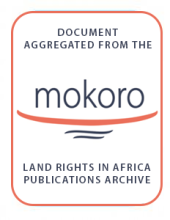/ library resources
Showing items 1 through 9 of 73.Includes what is ALL?, who owns ALL?, trouble at home, new findings, turning to new pastures as African Land reinvents itself. A cautionary tale of double deception.
Contains country context, study of land investment, benefits and impacts.
Examines political and social dynamics of foreign agricultural investment in Ethiopia.
The current Ethiopian government originated in a Marxist revolutionary movement, which early in its struggle against the Derg regime recognized the widespread discrimination against women in Ethiopian society and placed gender emancipation at the centre of its revolutionary strategy.
Recent UNRISD research finds that the new generation of land tenure reforms introduced in the 19990s is not necessarily more gender equitable than earlier efforts, even though women’s ability to gain independent access to land is increasingly on the statutes.
Looks at the institutional framework, at current key land policy and agrarian issues, and at the impact of land and agrarian reform. Makes a series of recommendations. Argues that the resettlement programme has failed with not a single project sustainable after 5 years.
Examines options for strengthening women’s participatory rights in the face of increasing commercial pressures on land in 3 countries: Mozambique, Tanzania, and the Philippines.
Examines policy and legal reforms in the 1990s; strengths of the 1995 Lands Act and civil society concerns about it; policy framework; Lands Tribunal; women’s constraints in customary land, alienation of land, inheritance and accessing urban land, government attempts to promote women’s access and
GRAIN has documented at least 135 farmland deals for food crop production that have backfired between 2007 and 2017. They represent 17.5 million hectares. These are not failed land grabs, since the land almost never goes back to the communities, but failed agribusiness projects.
Pagination
Land Library Search
Through our robust search engine, you can search for any item of the over 73,000 highly curated resources in the Land Library.
If you would like to find an overview of what is possible, feel free to peruse the Search Guide.

